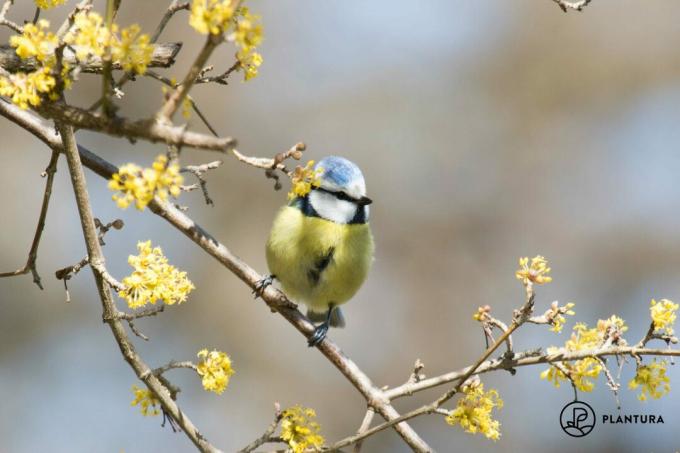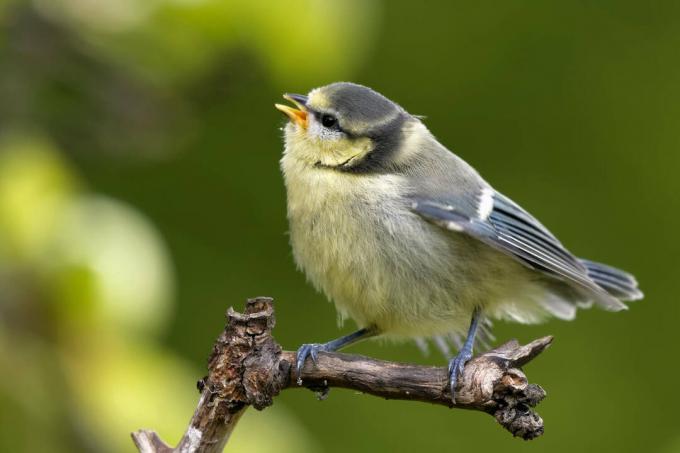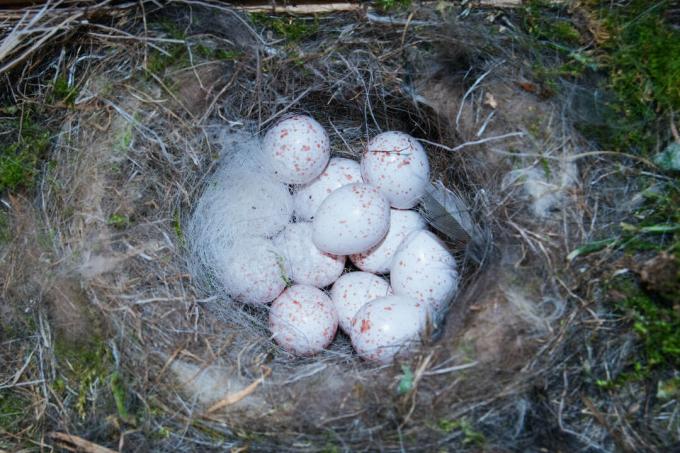What do blue tits look like, when do they breed and what do they eat? In this article we answer all questions about the domestic blue tit.

The blue tit (Cyanistes caeruleus) is also one of our smallest and most frequent guests in home gardens. At just 11 grams, it weighs less than a packet of baking powder and is anything but inconspicuous. In fact, with its colorful plumage and lively behavior, the blue tit is one of our most eye-catching species of birds. Basically, she can never sit still and even moves upside down on thin branches through the treetops.
contents
- Blue tits: a detailed profile
-
How to recognize the blue tit
- How does the song of the blue tit sound?
- How do you recognize the young birds?
- How do you recognize the eggs of the blue tit?
- How do female and male blue tits differ?
- Which habitat do blue tits prefer?
- Where do they build their nest?
- When do blue tits breed?
- Where do blue tits spend the winter?
-
Support blue tits: Here's how
- What do blue tits eat?
- Which nesting boxes are suitable for blue tits?
- How can you give blue tits additional support?
Blue tits: a detailed profile
| size | About 12 cm |
| weight | Approx. 11 g |
| Breeding season | April May |
| lifespan | Up to 5 years |
| habitat | Forests, parks and gardens |
| Feed preference | Insects and their larvae, seeds, berries (real "omnivores") |
| Threats | Decline in natural habitat and food supply |
How to recognize the blue tit
The blue tit is easy to recognize by its blue-green back and yellow underside. A dark, vertical line runs across the chest and stomach, the white face is traversed by a narrow, black eye stripe and the parting forms a blue "cap". One can only confuse the blue tit with the Great tit, which differs from its little sister by its slightly larger shape and the black-colored head. Since young blue tits and great tits already look quite similar to their parents, they can also be distinguished early on by the features mentioned.

How does the song of the blue tit sound?
The song of the blue tit begins with two high, clear elements and ends in a trilling stanza: "Tsi-tsi-tsürrrr". Overall, the bird's voice sounds very bright and lovely.
The blue tit song sounds like this:
How do you recognize the young birds?
Young blue tits are not yet as intensely colored as their parents. They are characterized by an inconspicuous blue-gray top and a whitish-yellow bottom. The eye stripe and the - at the beginning still gray - skull cap are formed early on, which means that the little ones can be recognized quite clearly.

How do you recognize the eggs of the blue tit?
A female lays an average of 7 to 13 eggs per brood, and clutches of up to 19 eggs have also been detected. The eggs are about the size of a fingernail, cream-colored and speckled with reddish tones. They are laid one after the other and only incubated when the clutch is complete.

How do female and male blue tits differ?
In contrast to many other bird species, blue tits have the same color as males and females, which is why it is very difficult to clearly determine the sex of an individual. Common features are the blue apex, which is usually more intense blue in males is than that of the females, and the black collar, that of the males, is somewhat broader and darker fails. However, these features vary between individuals and are not always clear, especially to the untrained eye.
Which habitat do blue tits prefer?
Naturally, blue tits prefer old deciduous forests, where they find plenty of food in the form of insects and spiders as well as nesting opportunities. Despite the current lack of this habitat, the blue tit is one of the most common bird species in Germany. The small birds have proven to be extremely adaptable and now colonize man-made structures such as parks and gardens on a large scale.
Where do they build their nest?
Blue tits are cave breeders and use natural tree hollows and crevices as breeding grounds in which they build nests out of moss and small twigs and then with animal hair and feathers pad. In the absence of suitable tree hollows, blue tits are very creative and find refuge in cracks in walls, holey facades or even old mailboxes.

When do blue tits breed?
The breeding season of the blue tit begins in mid-April. The eggs are incubated for around two weeks, and the young birds are fed in the nest for 16 to 18 days after hatching. Then the young fly out, but as so-called branchlings who are not yet experienced enough to support themselves, they remain dependent on their parents for some time. After the first brood has been successfully rearing, a second one occasionally follows, which can extend the breeding period to the beginning of August.
Where do blue tits spend the winter?
The blue tit is a in Germany Standing bird, that means, she spends the winter with us and does not move south. However, due to the reduced food supply, blue tits may retreat to reed areas and feed on the insect larvae that overwinter there. Smaller groups also often form in winter, in which the blue tits even hunt side by side with other species such as the great tit or the golden cockerel.
Support blue tits: Here's how
Due to the progressive loss of natural habitat, the blue tit, like many other bird species, is dependent on man-made habitats. There, however, important structures are often missing, such as old trees with caves and crevices in which the blue tits can build their nests. The food supply quickly becomes scarce, especially in winter. However, by offering food and artificial nesting facilities, it is easy to support the small birds.

What do blue tits eat?
Before feeding the birds, the question arises: what do blue tits eat? The diet of the blue tit consists mainly of insects and their larvae - especially when rearing nestlings, caterpillars make up a major part of the diet. But they also use a variety of seeds, nuts and berries and are therefore real omnivores. Who additionally bought or homemade birdseed would like to offer, should use sunflower seeds and peanut fragments. Fat cakes or tit dumplings are also gladly accepted. Our Plantura corn dumplings are an ideal choice for this because they consist of natural, nutrient-rich ingredients and come without Plastic nets that cause rubbish and in which the little tits get entangled and injured could. A special feature that all tits have in common is that they prefer hanging feeding places.
Which nesting boxes are suitable for blue tits?
Since blue tits are cave breeders, an offered nest box should be except for a round one The entrance hole must be closed all around (opening it for occasional cleaning, however, should be possible be). An ordinary tit box, which is suitable for all species, has an entrance hole of 32 mm. Those who specifically support blue tits and want to rule out competition with the somewhat larger great tit should, however, choose an entrance hole of 26-28 mm.
How can you give blue tits additional support?
If you want to give your blue tits breeding in the nesting box additional support, you can ensure that there is a sufficient natural supply of food. In fact, there are often not enough caterpillars in gardens to raise the young. This can be remedied by promoting popular food plants for the caterpillars, such as nettle, blackberry, willow or sloe. Furthermore, the use of chemical pesticides should be avoided, as these are both have a negative impact on the supply of caterpillars and also have toxic effects on the birds via the food chain can.
In addition to additional food, a Bird bath be installed in the garden, which is particularly useful in hot temperatures. This should be flat enough that the birds can stand in it and - since the bowls are also used as a bath - should be cleaned regularly.
In addition, all measures to promote insects are of course also good for the blue tit - such as creating a meadow for beneficial insects. Our Plantura beneficial insect magnet offers a wide range of food and habitat for numerous insect species.
More tips for the Design of an insect-friendly garden You will find here. Of course, this also benefits other bird species, such as the Great tit.



